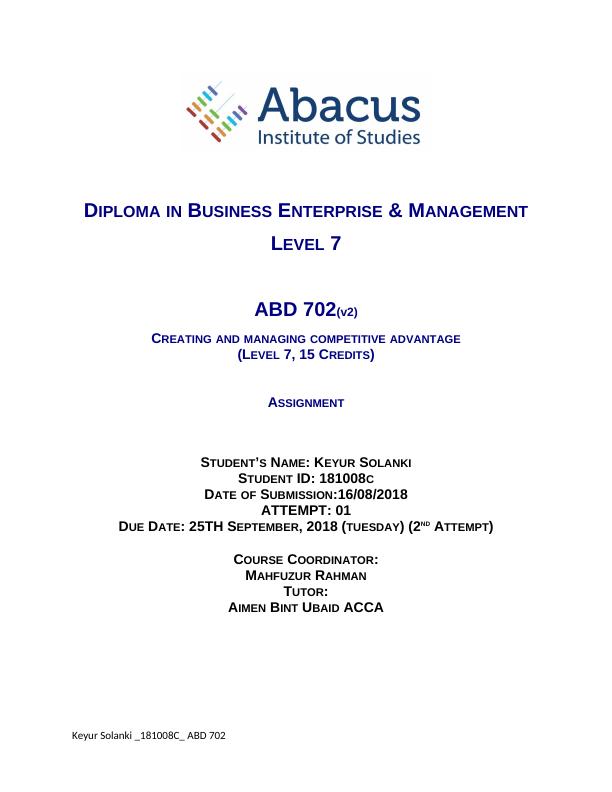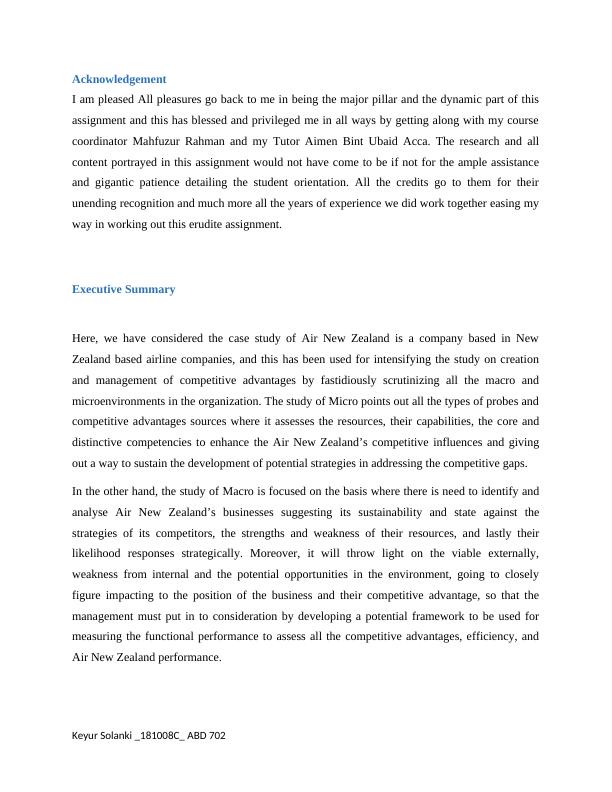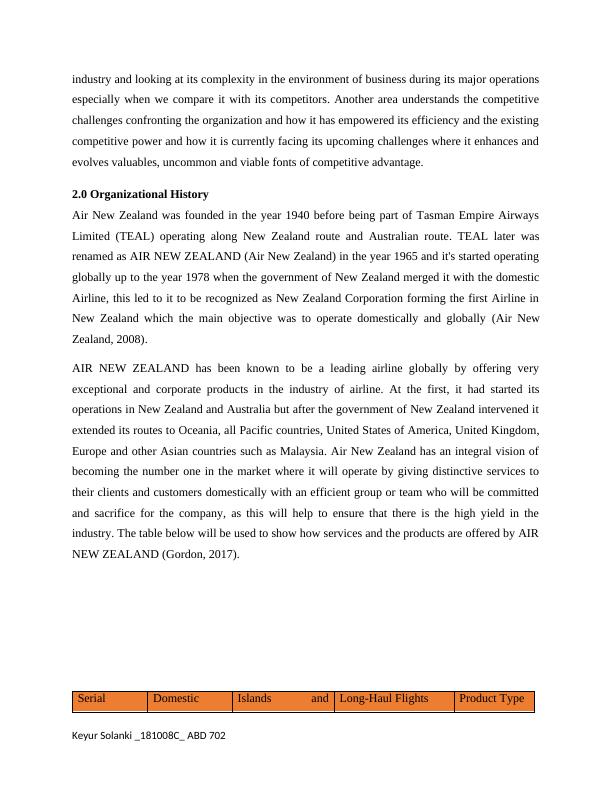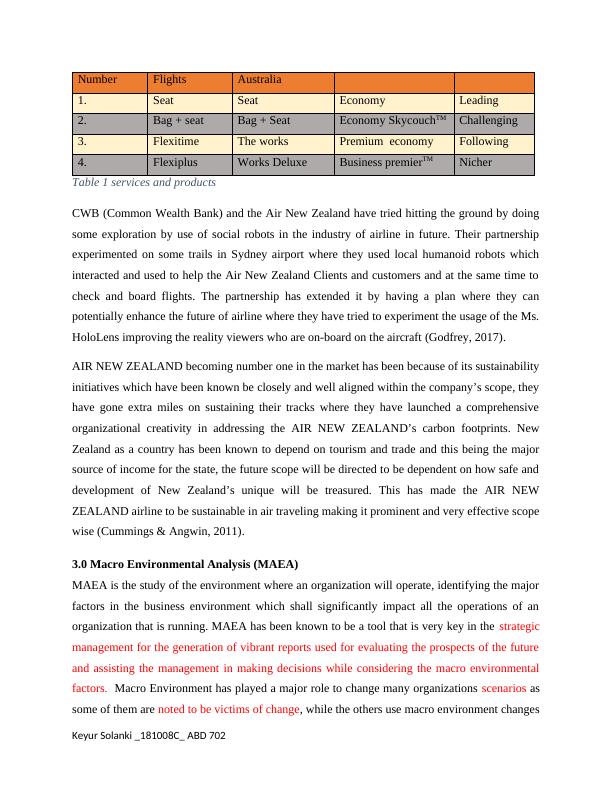Creating and Managing Competitive Advantage - Air New Zealand Case Study
This assignment requires the production of a business report for an existing organization or scenario involving a specific problem(s) to be solved and decision(s) to be made. The report should be presented in a word-processed format with appropriate headings, page and section numbering, indentations, figures and tables, and appendices. The information and arguments presented must be supported and validated by appropriate references using APA 6th Referencing Style. The assignment is to be submitted electronically via the Abacus Institute Moodle platform.
Added on 2023-06-09
About This Document
Creating and Managing Competitive Advantage - Air New Zealand Case Study
This assignment requires the production of a business report for an existing organization or scenario involving a specific problem(s) to be solved and decision(s) to be made. The report should be presented in a word-processed format with appropriate headings, page and section numbering, indentations, figures and tables, and appendices. The information and arguments presented must be supported and validated by appropriate references using APA 6th Referencing Style. The assignment is to be submitted electronically via the Abacus Institute Moodle platform.
Added on 2023-06-09
LEVEL 7
ABD 702(v2)
CREATING AND MANAGING COMPETITIVE ADVANTAGE
(LEVEL 7, 15 CREDITS)
ASSIGNMENT
STUDENT’S NAME: KEYUR SOLANKI
STUDENT ID: 181008C
DATE OF SUBMISSION:16/08/2018
ATTEMPT: 01
DUE DATE: 25TH SEPTEMBER, 2018 (TUESDAY) (2ND ATTEMPT)
COURSE COORDINATOR:
MAHFUZUR RAHMAN
TUTOR:
AIMEN BINT UBAID ACCA
Keyur Solanki _181008C_ ABD 702

I am pleased All pleasures go back to me in being the major pillar and the dynamic part of this
assignment and this has blessed and privileged me in all ways by getting along with my course
coordinator Mahfuzur Rahman and my Tutor Aimen Bint Ubaid Acca. The research and all
content portrayed in this assignment would not have come to be if not for the ample assistance
and gigantic patience detailing the student orientation. All the credits go to them for their
unending recognition and much more all the years of experience we did work together easing my
way in working out this erudite assignment.
Executive Summary
Here, we have considered the case study of Air New Zealand is a company based in New
Zealand based airline companies, and this has been used for intensifying the study on creation
and management of competitive advantages by fastidiously scrutinizing all the macro and
microenvironments in the organization. The study of Micro points out all the types of probes and
competitive advantages sources where it assesses the resources, their capabilities, the core and
distinctive competencies to enhance the Air New Zealand’s competitive influences and giving
out a way to sustain the development of potential strategies in addressing the competitive gaps.
In the other hand, the study of Macro is focused on the basis where there is need to identify and
analyse Air New Zealand’s businesses suggesting its sustainability and state against the
strategies of its competitors, the strengths and weakness of their resources, and lastly their
likelihood responses strategically. Moreover, it will throw light on the viable externally,
weakness from internal and the potential opportunities in the environment, going to closely
figure impacting to the position of the business and their competitive advantage, so that the
management must put in to consideration by developing a potential framework to be used for
measuring the functional performance to assess all the competitive advantages, efficiency, and
Air New Zealand performance.
Keyur Solanki _181008C_ ABD 702

PESTEL
Micro and Macro Environment Analysis
Positioning Map
SWOT Analysis
Porter Five Forces Model
Value Chain
Competitive Advantage
Balance Score Board
Sustainability
Key Words
Customers
Corporate
Globalisation
Competitive Advantage
The management
Organisation
The industry
New Zealand
Air New Zealand
Airtime Industry
Company
List of Figures
Figure 1 Positioning Mapping.............................................................................................16
Figure 2 porter five forces model....................................................................................17
Figure 3 Balanced scorecard framework.................................................................................43
List of Tables
Table 1 services and products....................................................................................................7
Table 2 Macro environmental Analysis.....................................................................................9
Keyur Solanki _181008C_ ABD 702

Table 4: Entry Threat...............................................................................................................20
Table 5: substitute threat..........................................................................................................21
Table 6: Powerful Buyer Threat...............................................................................................22
Table 7Power buyer threat.......................................................................................................24
Table 8: Opportunity Rivalry...................................................................................................25
Table 9: Opportunity Entry......................................................................................................27
Table 10 Substitute opportunity...............................................................................................27
Table 11 Powerful buyer opportunities....................................................................................29
Table 12 industrial critical success factors...............................................................................31
Table 14 identifying & analysing the competitive gaps...........................................................40
Table 15Strategic Choices........................................................................................................42
Table of Contents
Acknowledgement...............................................................................................................................2
Executive Summary............................................................................................................................2
List of Figures.....................................................................................................................................4
List of Tables......................................................................................................................................4
1.0 Introduction..................................................................................................................................6
2.0 Organizational History..................................................................................................................6
3.0 Macro Environmental Analysis (MAEA)......................................................................................7
4.0 Micro-Environmental Analysis (MIEA)......................................................................................12
4.1 Industrial Key Characteristics................................................................................................12
4.2 Competition Mapping.............................................................................................................15
4.3 Environmental Threats...........................................................................................................17
4.4 Potential Opportunities...........................................................................................................23
4.5 Industrial success critical factors................................................................................................26
5.0 Internal Environmental Analysis................................................................................................30
5.1 Competitive Strengths.............................................................................................................30
5.2 Degree of Competitive strengths.............................................................................................31
5.3 Organisational Weakness........................................................................................................33
5.4 Competitive Gaps....................................................................................................................36
Keyur Solanki _181008C_ ABD 702

7.0 Performance Measurement Framework.....................................................................................42
7.1 Developing Framework to Measure Performance of Air New Zealand..............................43
7.2 Implications and Limitations.....................................................................................................44
7.2.1 Implications...............................................................................................................................44
7.2.2 Limitations................................................................................................................................44
8.0 Summary and Conclusion...........................................................................................................45
List of References..............................................................................................................................46
1.0 Introduction
In this case study, the main reason for researching and doing this report understands the way
New Zealand operates and where it is based on i.e. such as understanding the facts in the
Keyur Solanki _181008C_ ABD 702

especially when we compare it with its competitors. Another area understands the competitive
challenges confronting the organization and how it has empowered its efficiency and the existing
competitive power and how it is currently facing its upcoming challenges where it enhances and
evolves valuables, uncommon and viable fonts of competitive advantage.
2.0 Organizational History
Air New Zealand was founded in the year 1940 before being part of Tasman Empire Airways
Limited (TEAL) operating along New Zealand route and Australian route. TEAL later was
renamed as AIR NEW ZEALAND (Air New Zealand) in the year 1965 and it's started operating
globally up to the year 1978 when the government of New Zealand merged it with the domestic
Airline, this led to it to be recognized as New Zealand Corporation forming the first Airline in
New Zealand which the main objective was to operate domestically and globally (Air New
Zealand, 2008).
AIR NEW ZEALAND has been known to be a leading airline globally by offering very
exceptional and corporate products in the industry of airline. At the first, it had started its
operations in New Zealand and Australia but after the government of New Zealand intervened it
extended its routes to Oceania, all Pacific countries, United States of America, United Kingdom,
Europe and other Asian countries such as Malaysia. Air New Zealand has an integral vision of
becoming the number one in the market where it will operate by giving distinctive services to
their clients and customers domestically with an efficient group or team who will be committed
and sacrifice for the company, as this will help to ensure that there is the high yield in the
industry. The table below will be used to show how services and the products are offered by AIR
NEW ZEALAND (Gordon, 2017).
Serial Domestic Islands and Long-Haul Flights Product Type
Keyur Solanki _181008C_ ABD 702

1. Seat Seat Economy Leading
2. Bag + seat Bag + Seat Economy SkycouchTM Challenging
3. Flexitime The works Premium economy Following
4. Flexiplus Works Deluxe Business premierTM Nicher
Table 1 services and products
CWB (Common Wealth Bank) and the Air New Zealand have tried hitting the ground by doing
some exploration by use of social robots in the industry of airline in future. Their partnership
experimented on some trails in Sydney airport where they used local humanoid robots which
interacted and used to help the Air New Zealand Clients and customers and at the same time to
check and board flights. The partnership has extended it by having a plan where they can
potentially enhance the future of airline where they have tried to experiment the usage of the Ms.
HoloLens improving the reality viewers who are on-board on the aircraft (Godfrey, 2017).
AIR NEW ZEALAND becoming number one in the market has been because of its sustainability
initiatives which have been known be closely and well aligned within the company’s scope, they
have gone extra miles on sustaining their tracks where they have launched a comprehensive
organizational creativity in addressing the AIR NEW ZEALAND’s carbon footprints. New
Zealand as a country has been known to depend on tourism and trade and this being the major
source of income for the state, the future scope will be directed to be dependent on how safe and
development of New Zealand’s unique will be treasured. This has made the AIR NEW
ZEALAND airline to be sustainable in air traveling making it prominent and very effective scope
wise (Cummings & Angwin, 2011).
3.0 Macro Environmental Analysis (MAEA)
MAEA is the study of the environment where an organization will operate, identifying the major
factors in the business environment which shall significantly impact all the operations of an
organization that is running. MAEA has been known to be a tool that is very key in the strategic
management for the generation of vibrant reports used for evaluating the prospects of the future
and assisting the management in making decisions while considering the macro environmental
factors. Macro Environment has played a major role to change many organizations scenarios as
some of them are noted to be victims of change, while the others use macro environment changes
Keyur Solanki _181008C_ ABD 702

unturned when they are utilizing those changes to their advantage, if they are warned in advance
then it becomes the major objective of MAEA (Gupta, 2013). In this case of AIR NEW
ZEALAND, we will use PESTEL analysis for analysing the Macro environment factors and
evaluating their prospects.
Factors Discussion Strategic Implications
Quantitative Qualitative Commitment Focal
Political
Above 3million
visitors at the end
of march in 2017,
making an annual
increase of about
9% from 2016 in
the month of
march.
These policies
which are feasible
have played very
major role in the
NZ government as
tourism has
boosted the
earnings of NZ.
Increment in the
number of seats
by 9% of flights
domestically
leading to hit the
60,000 in the
summer of 2017.
its focal in
the essence
that it takes
current
advantages
of ME
factors hence
increasing
the revenue
and profits
Legal and
Regulatory
AIR NEW
ZEALAND must
always comply
with the
following 4 laws:
1. Global Laws
2. New Zealand
Laws
3. Principles and
standards
4. Anti-money
AIR NEW
ZEALAND has
been known for
complying with all
laws and
regulations
applicable which
made it to be
ranked number one
safest airline in the
year 2014 by
AIR NEW
ZEALAND has
ensured timely
disclosure to all
material info
under the laws
and committing
to the highest
standards of the
code of
conducts.
Very much focal
for AIR NEW
ZEALAND as they
need to comply
with all the laws
and regulations
applicable and to
the most high
standards.
Keyur Solanki _181008C_ ABD 702

End of preview
Want to access all the pages? Upload your documents or become a member.
